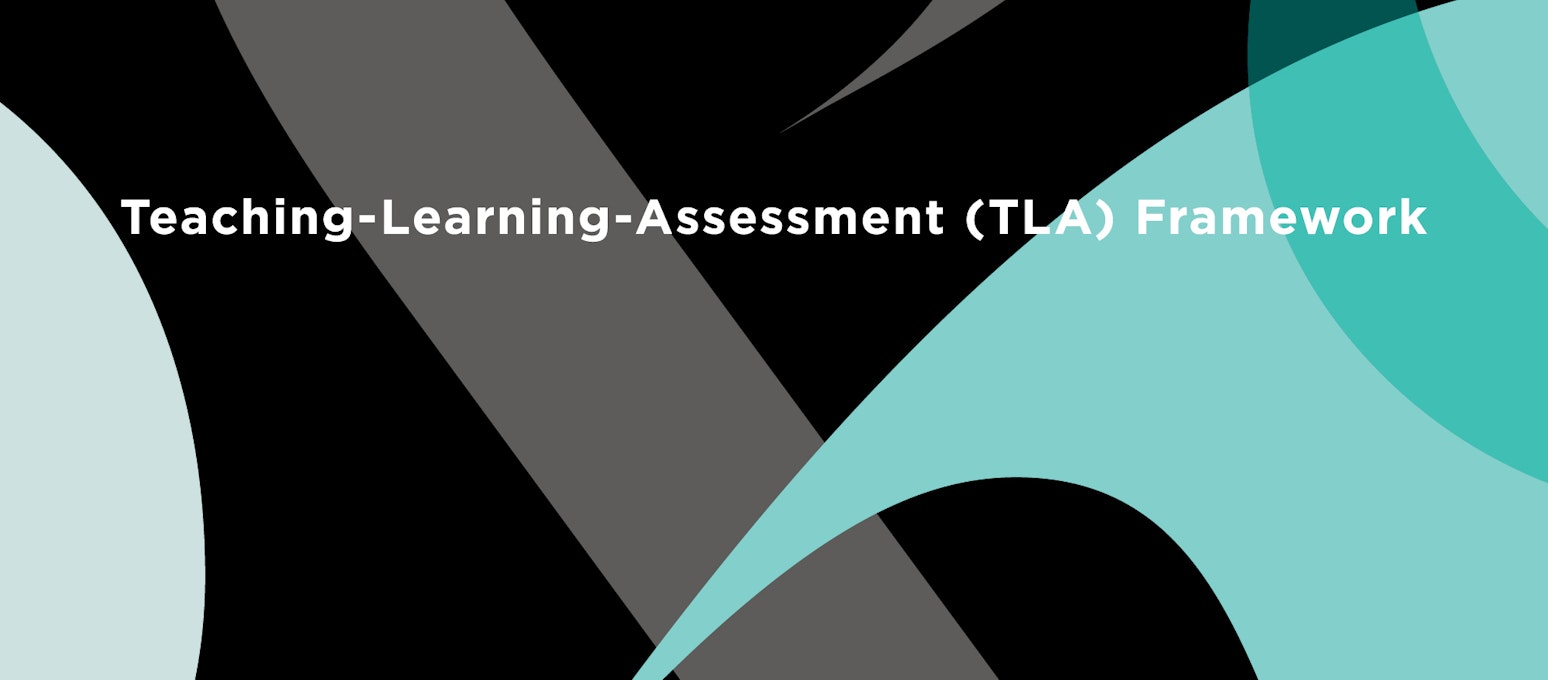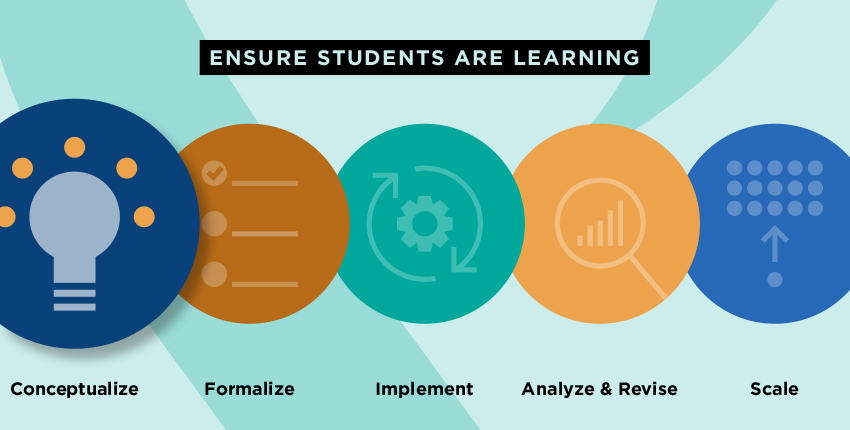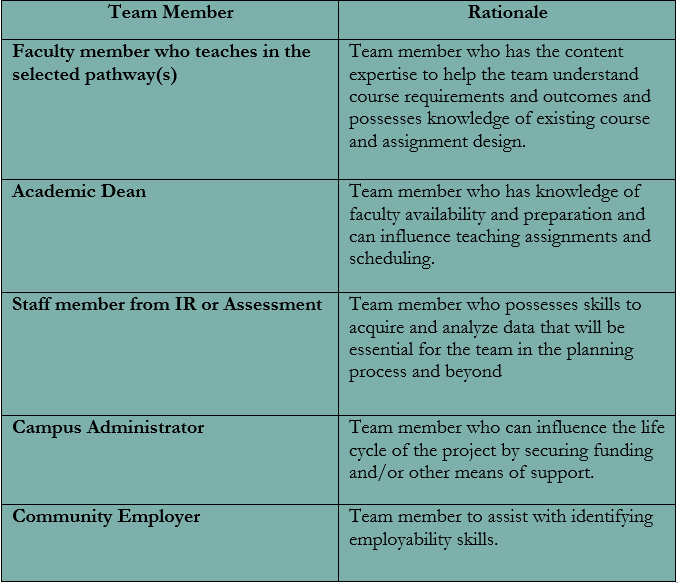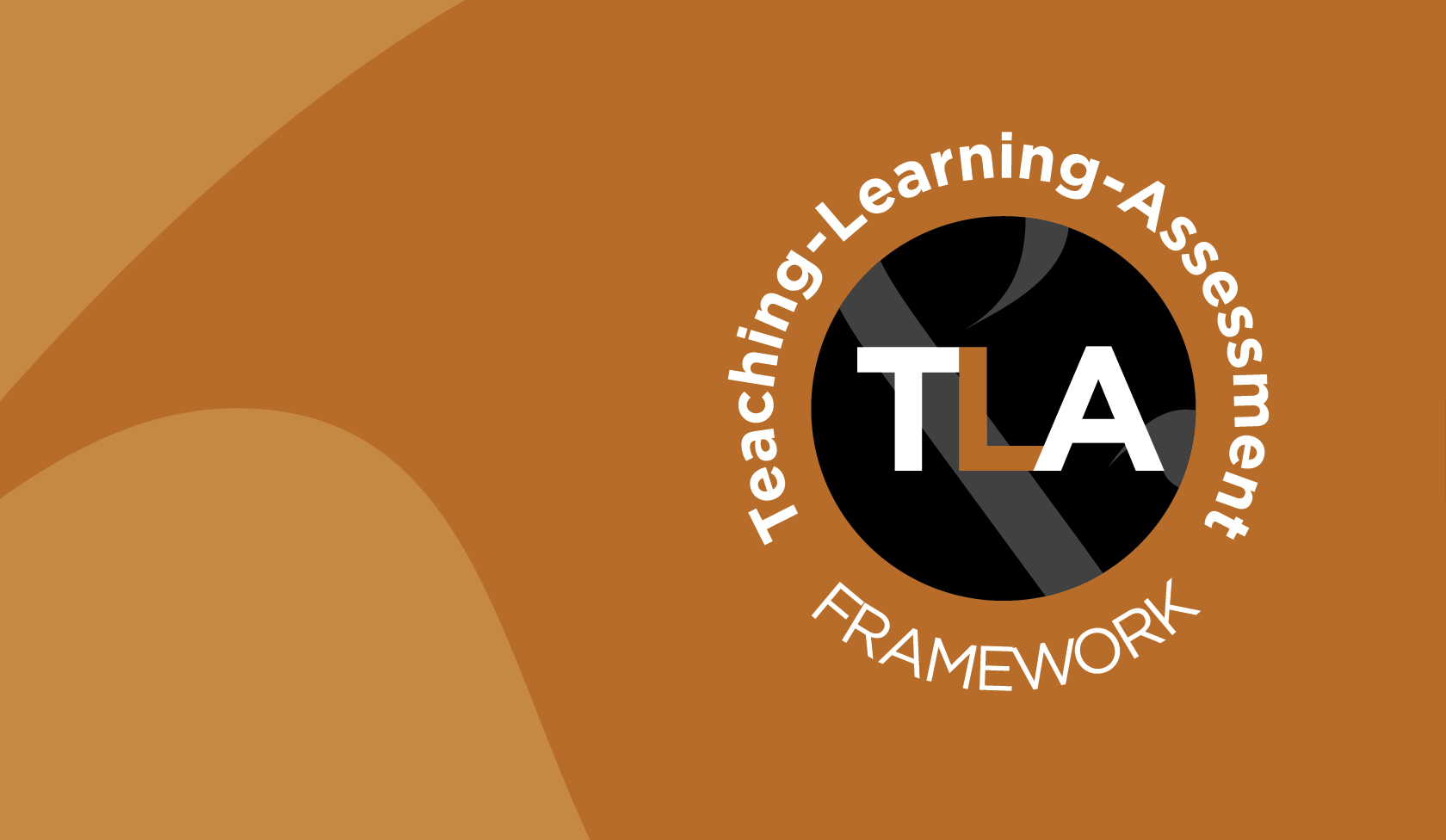

None
Phase 1: Conceptualize
In this first phase of the TLA Framework, campuses will assess institutional readiness, consider campus context, and identify focused pathways to prepare for planning and implementation. In preparation for the next phases of the framework, campuses will consider guiding questions and utilize self-assessment tools to take inventory of existing practices related to pedagogy, student learning outcomes, equity-consciousness, professional development, and assessment.

An essential part of the TLA process, the Conceptualize phase prepares campuses to advance efforts in the formalizing and implementation phases and establishes foundational components of the process including equity considerations, team make-up, and long-term goals. In the Conceptualize phase, teams will be guided through:
Guiding Questions
Consider these guiding questions as you move through the Conceptualize phase.
- What are some existing high-impact practices (HIPs) on your campus? How does your institution assess HIPs to ensure students are learning? Are students meeting the expectations? How is equity addressed within these practices?
- In identifying faculty members for your project team, who is committed to engaging in your project? Who brings relevant expertise, experience, and influence to advance the project goals?
- What are the academic programs and/or meta-major(s) with defined learning outcomes that will be the focus for your project?
- What are the defined learning outcomes for those programs and/or meta-major(s)?
- How are these learning outcomes aligned with the skill sets employers are seeking?
- How does your institution assess the quality of the project-based, collaborative learning experiences that help students achieve proficiency in the learning outcomes?
- What are the current professional development opportunities to help faculty in the design and implementation of these educational practices?
- Does your campus have an Office of Institutional Research or an Office of Institutional Effectiveness with a person responsible for overseeing the reporting of student outcomes (GPA, retention, graduation)?
- How would you describe the current environment for assessment at the institution?
- What are the greatest resources and opportunity gaps related to assessment of student learning on your campus?
- What are some major obstacles to implementing the Ensure Students Are Learning pillar of the Guided Pathways framework?
- What is the infrastructure in place for assessing student learning outcomes?
- Does your institution use rubrics to assess student learning outcomes for academic programs and/or meta-majors?
- Does your institution use AAC&U VALUE rubrics, whether modified or unmodified, to assess learning outcomes? If yes, which VALUE rubrics are used, and how/where?
The authentic exercise of equity and equity-mindedness requires explicit attention to structural inequality and institutional racism.

Defining Equity-Mindedness
Equity-mindedness is a mindset that higher education practitioners must adopt to create race-conscious change. Estela Bensimon, founder of the Center for Urban Education (CUE), developed the definition of equity-mindedness and a set of twelve indicators to help institutions recognize and dismantle racialized systems, structures, policies, and practices that perpetuate racism and inequity.
Starting the Equity Conversation
Equity Issue Briefs & Resources
The Office of Community College Research and Leadership (OCCRL)--located within the College of Education at the University of Illinois at Urbana-Champaign--developed Equity Conscious Community College Pathways resources that include equity issue briefs, equity-focused video vignette series, and a culturally sustaining stories podcast series, to explore equity-centered practices for college faculty and leaders to use in ensuring that all students are learning. Campuses can use these resources to facilitate insightful discussions surrounding equity-minded approaches to teaching and learning practices, student success and engagement, and leadership.
Discussion Guides
These guides were developed by the National Center for Inquiry and Improvement (NCII) to support institutions' critical conversations around racial justice in teaching and design practices. The discussion guides cover the various intersections of guided pathways and equity, and can assist campuses in starting a discussion regarding equity, especially when considering rationales for selecting a project pathway.
Our conversations have shifted dramatically in this time period. Equity is now a central feature of our teaching and learning conversations.
Campus Spotlights: Equity
Driven by the necessity for an equity-minded approach to curriculum, assessment, and pedagogy, the Monroe Community College (MCC) team focused on exploring and understanding the student experience, and how it contributes to persisting equity gaps on campus. The pilot project team intentionally strengthened its efforts in understanding how non-cognitive challenges such as work, familial, and personal responsibilities, play a role in creating barriers to students’ achievement; for example, these external challenges may prevent certain students from enrolling in HIP-designated courses, simply due to time constraints and conflicting priorities.
In response to these challenges and with the individual student experience in mind, the project team worked collaboratively across departments to center equity-mindedness and race-conscious practices at every institutional level. MCC’s Teaching and Creativity Center also engaged faculty in a series of professional development and workshop opportunities surrounding equity-focused pedagogy, assessment, and curriculum development. In examining the responsibility that educators have in practicing and role modeling race-consciousness, MCC and the Teaching and Creativity Center produced a video that features several students sharing their stories about experiencing microaggressions in the classroom from other students, faculty, and administrators. The video allowed students to share their lived experiences related to microaggressions and discrimination based on race, gender, ability, mental health, age, etc. The lived experiences of students like the ones shared in the video have helped inform MCC’s approach to supporting, building capacity, and creating accountability for equity-minded, race-conscious practitioners. The student video, that debuted at an “essential discussion” event hosted by MCC in 2019 with regional educators, can be viewed here.
The project team also focused its efforts around utilizing the VALUE Scoring Collaborative and rubrics, enhancing, and expanding high-impact practices (HIPs), ensuring faculty are employing equity-minded practices at every level through sustained DEI professional development opportunities, strategic changes to programming, and implementing a more equity-aligned approach to curricular/pedagogical assessment.
Read more about Monroe Community College’s work here.
Data analysis is an essential component of the TLA process. It helps campuses understand patterns and trends in student learning and success. However, disaggregating the institutional data gets at the core of racial inequity issues present on campuses. The VALUE Scoring Collaborative provides campuses with disaggregated data reports to highlight existing equity gaps in student learning outcomes and achievements. Many of the twenty pilot institutions have embraced disaggregated data analysis as a method of tackling institutional equity concerns. At Kapi’olani Community College, collecting student data has become a primary focus in addressing equity. Below is Kapi’olani Community College’s approach to using data to understand existing inequities and bridge gaps:
Concentration/Pathway Areas: Psychology, Education, Economics, Engineering, Information & Communication Sciences
Concern: Little to no evidence exists to indicate that data have been disaggregated to examine inequities in student engagement, learning, and achievement within these concentrations.
Project Goals:
- Utilize the VALUE Critical Thinking Rubric to examine whether and where inequities exist in student engagement, learning, and achievement.
- Examine the inequities of student engagement, learning, and achievement within the concentrations.
- Use assessment data to inform teaching and learning practices through an equity lens.
Methods of Implementation:- Created and disseminated an equity-minded participant survey about the following:
- Definition of equity/equity-minded practices
- Syllabus & assignments
- Classroom practices
- Teaching practices
- Assessment
- Collaborated with the Office of Institutional Effectiveness to gain insights on analyzing data from the rubric and survey and interpreting the disaggregated data to determine the inequities in student engagement, learning, and achievement.
- Collected over 100 student artifacts for VALUE Scoring Collaborative assessment data, scoring, disaggregated data report.
- Organized student data into categories.
- Collaborated with faculty and college’s institutional research office to ensure accurate student data is being collected.
- Developed clearer criteria for random selection of student artifacts and sampling to ensure equitable assessment.
Crafton Hills College focused on the importance of examining data when attempting to close equity gaps in student learning and success. When defining its goals, the project team looked at disaggregated student retention and success data to see where inequities existed and among which groups of students.
The Crafton Hills project team also identified how data analysis and data literacy are shared responsibilities, and the factors needed to understand and interpret data in an effective, intentional way. The project team was intentional about presenting data trends that highlight concerns, and how data can be used to address them through certain high-impact practices. They found that data can be used to transform the student experience and improve success in several areas:
- Collaborative learning
- Supplemental instruction
- Tutoring centers
- Embedded tutoring
- Counseling services
- Transfer resources

Team Discussion Activity: Equity
The Monroe Community College project team conceptualized a future protocol in relation to equity-mindedness by engaging in a reflective activity.
Imagine that in a few years from now, your institution has achieved becoming an equity-minded, race-conscious campus. Consider asking the following questions:
- What does our campus look like now?
- What did it look like before?
- How did we get here?
- What were the obstacles that we had to face, and how did we overcome them?
Assessing Campus Readiness
Complete the Scale of Adoption Self-Assessment (SOAA)
Developed by the Community College Research Center (CCRC), this assessment tool determines campus readiness based on the level of engagement in each pillar of the Guided Pathways model, from “not occurring” to “at scale,” while including equity considerations for each practice. Campuses can use this tool to assess readiness for focusing on the fourth pillar. To access this assessment tool for your campus, click here.
Complete a Campus Baseline Inventory
This baseline inventory helps campuses identify existing practices related to the five components of the Ensure Students Are Learningpillar. Consider completing this inventory with your campus team to determine how the five pillar components are being integrated into existing practices and where these data are being sourced, to inform your thinking about next steps. Use the table below for a guide to completing a baseline inventory:


Identifying a Pathway
Campuses should identify a project pathway that aligns with needs revealed from campus assessment and disaggregated data analysis; chosen pathways should be supported by both an academic and equity-focused rationale.
Consider the following question as you work to identify a pathway(s):
- When evaluating the disaggregated data results from your campus self-assessment and inventory activities; what program(s), course(s), meta-major(s) revealed gaps in equity in student outcomes and assessment of student learning?
Campus Spotlight: Identifying a Pathway
The Chattanooga State Community College team identified a high-enrollment project pathway based on a disaggregated data analysis that highlighted significant gaps between student outcomes and success rates. Below is the team's rationale and evidence for identifying a pathway:
The academic program of study selected as a focus of this work is an Associate of Science in Health Profession. This Health Science meta-major is the pathway followed by students who wish to matriculate to any Chattanooga State Associate of Science or Associate of Applied Science within the Allied Health Division or bachelor’s degree transfer program. This Health Sciences pathway is the most declared major at Chattanooga State. On average, approximately 42 percent of each freshman class selects this pathway while completing general education requirements that prepare them for highly specialized programs of study at Chattanooga State and/or transfer to a four-year university or college.
Students who entered this pathway in the fall of 2018 represented approximately one-third of the first-time freshman class (588 students). Seventy-five percent of this cohort were White students, while sixty-two percent were academically underprepared, sixty-five percent were low-income students, and 39 percent were first-generation students. By the end of the 2018 academic year, 21 percent (123 students) had changed their academic program/major.
The college adopted a college success course in 2015. Each academic division offers a division-specific college success course for students seeking a degree in the academic area. The College Success Course for Health Sciences (CSHS1000) routinely offers twenty-two sections each fall term. The success rate of 67 percent represents students who completed the course with a grade of “C” or better. Success rates for Black and Hispanic students were 51 percent and 60 percent respectively, while White students’ success rate was 68 percent, significantly higher than underrepresented minority students. In addition, 61 percent of the students were academically underprepared upon entering the course, and 61 percent were low-income students.Read more about Chattanooga State Community College’s work here.
Tip: Clarify Project Goals
Clearly defining goals from the start will help focus your campus team and make sure that actions reflect goals. Be sure to revisit defined goals throughout the duration of the project to ensure your campus team is on track and progress is being made.

In Defining Goals, Consider the Following:
- How will the project goals impact student success and promote equity-mindedness at your institution?
- How will these goals be assessed and/or measured?
- How do these goals foster faculty engagement and collaboration?
- How do these goals align with the skill sets that employers are seeking?
- How do these goals integrate the five components of the Ensure Students Are Learning pillar?
Campus Spotlight: Defining Project Goals
During the Conceptualize phase, Miami Dade College defined its project goals based on an intended student learning outcome; assessment of workforce readiness; high-impact, applied learning experiences; and leveraging of institutional resources and stakeholders. The project team considered the core elements of the Ensure Students Are Learning pillar, and set intentional project goals to prompt positive student outcomes within the chosen pathway. See defined project goals below:
Identified Pathway: School of Justice – Criminal Justice Associate in Science Degree
Student Learning Outcome: Written Communication
Defined Project Goals:
- Coordinate teaching practices & learning supports to increase student mastery of learning outcome.
- Embed common written assignments and rubrics in 6 pathway courses.
- Infuse writing-to-learn strategies:
- Compose academic, discipline, and career-specific writing
- Explore and demonstrate student career knowledge through written responses to applied learning experiences
- Assess and evaluate workforce readiness based on student performance in selected learning outcome
- Low-stakes reflective writing on cocurricular activities
- Put data at the center and seek equity through disaggregated student data analysis.
- Leverage resources within current infrastructures (academic writing coaches, writing tutors, communities of interest), and institutional commitment to project goals (executive leadership, academic affairs, student affairs, institutional research, and the Center for Institutional and Organizational Learning).
Forming a Project Team
Having a project team that includes campus influencers and change agents who represent the diversity of the institution is critical to successfully ensuring students are learning. AAC&U recommends that campus teams include faculty from identified pathways, an academic dean, a staff member from Institutional research (IR) or assessment, a campus administrator, and a community employer. Keep in mind that team composition may vary based on conditions at each campus. The table below illustrates an example of project team composition.


Team Reflection Activity
- What have campus self-assessment and baseline inventory exercises revealed about existing practices and disparities on your campus? How will this help guide project planning?
- What did your team learn by analyzing disaggregated data when identifying a pathway(s)? How will your team consider this analysis in the next stages of planning?
- Reflect on what your team discovered about equity on your campus during the Conceptualize Phase. How will these perspectives on equity be used in the next phases of project planning?
- Reflect on the rationale behind choosing each of your project team members. How will your team continue to operate as a diverse, inclusive, and influential group as the process takes form?
Key Takeaways
- Complete CCRC’s Scale of Adoption Self-Assessment tool to help your team determine readiness based on existing levels of engagement with the pillars of the Guided Pathways model.
- Complete a campus baseline inventory to take stock of existing practices, implementation of the five components of the Ensure Students Are Learning pillar, and equity and assessment gaps at your institution.
- When choosing a pathway(s), consider disaggregated data analysis and what previous assessment results have highlighted.
- Chosen pathways should have both an academic and equity rationale behind them.
- Look for a pathway(s) that reveals gaps in equity and assessment.
- Consider how defined outcome goals integrate all five components of the Ensure Students Are Learning pillar.
- Revisit these defined outcome goals throughout the process to ensure forward progress.
- Choose team members who reflect the diversity of your institution; choose influential members and change agents on campus.
- Try to include a pathway faculty member, an academic dean, an IR or assessment staff member, a campus administrator, and a community employer.
- At the forefront of your efforts should be consideration of equity and practicing equity-mindedness.
- Ensure that your team has a clear understanding of what it means to practice equity-mindedness at an institutional level.
- Utilize the provided resources to understand equity-minded practices and how to create equity-driven change at every level.
Conceptualize Resources
Engage with the resources below, selected to help campuses consider areas of focus introduced in this first Conceptualize phase.
 Guided Pathways Resource Center
Guided Pathways Resource Center
 Pathways Leader Toolkit
Pathways Leader Toolkit
 CCRC Scale of Adoption Self-Assessment
CCRC Scale of Adoption Self-Assessment
 CCRC Redesigning Your College Through Guided Pathways
CCRC Redesigning Your College Through Guided Pathways
 AAC&U Peer Review: Taking Equity-Minded Action to Close Equity Gaps, Estela Bensimon
AAC&U Peer Review: Taking Equity-Minded Action to Close Equity Gaps, Estela Bensimon
 Center for Urban Education (CUE) Racial Equity Tools
Center for Urban Education (CUE) Racial Equity Tools
 CUE Equity-Mindedness Guide
CUE Equity-Mindedness Guide
 OCCRL: Exploring and Engaging Equity Video Vignette Series
OCCRL: Exploring and Engaging Equity Video Vignette Series
 OCCRL: Ensure Students Are Learning Equity Issue Briefs
OCCRL: Ensure Students Are Learning Equity Issue Briefs
 CCCSE Ensure Students Are Learning Web Toolkit
CCCSE Ensure Students Are Learning Web Toolkit
 CCCSE Building Momentum: Using Guided Pathways to Redesign the Student Experience
CCCSE Building Momentum: Using Guided Pathways to Redesign the Student Experience
 CCCSE Teaching and Learning Within a Guided Pathways Framework Playbook
CCCSE Teaching and Learning Within a Guided Pathways Framework Playbook
 National Center for Inquiry and Improvement (NCII): Advancing Equity through Guided Pathways Series
National Center for Inquiry and Improvement (NCII): Advancing Equity through Guided Pathways Series
 Becoming a Student-Ready College, McNair, et al.
Becoming a Student-Ready College, McNair, et al.